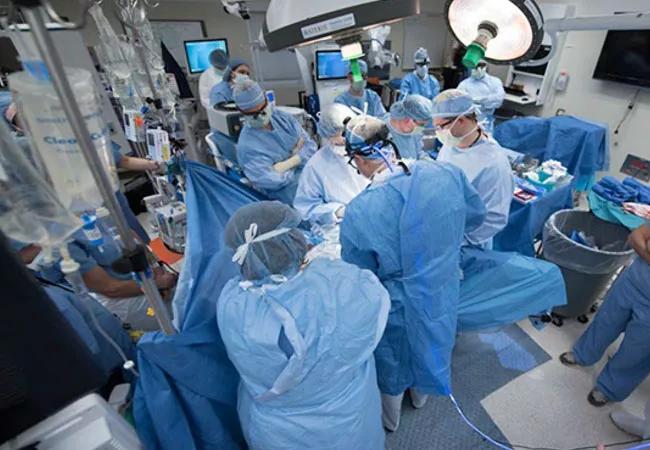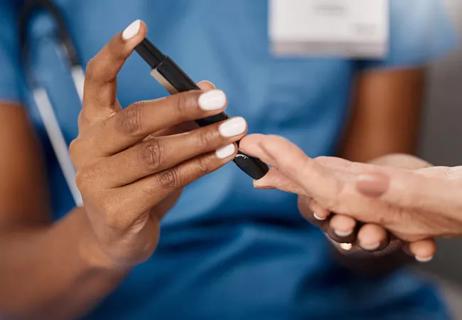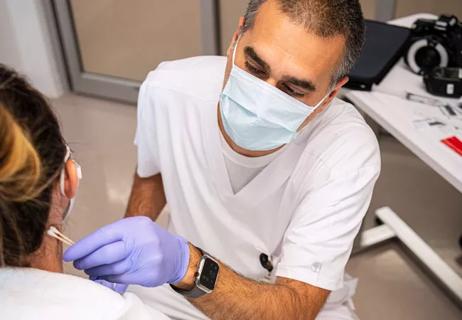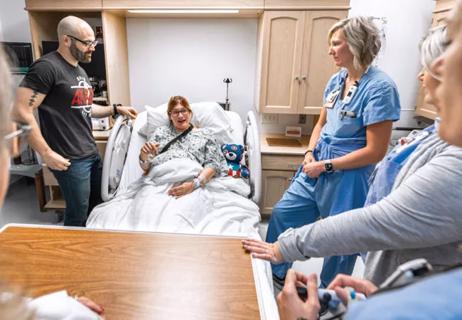One year later, nurses reflect on the special delivery

One year ago, Cleveland Clinic became the first healthcare organization in the U.S. to deliver a baby from a deceased-donor uterine transplant.
Cleveland Clinic is a non-profit academic medical center. Advertising on our site helps support our mission. We do not endorse non-Cleveland Clinic products or services. Policy
The transplant and birth are part of Cleveland Clinic’s ongoing ‘Uterus Transplantation for the Treatment of Uterine Factor Infertility’ research trial for women who are unable to have a baby due to uterine factor infertility (UFI).
In Cleveland Clinic’s first and history-making delivery, the donor uterus was transplanted in late-2017, the patient got pregnant through in-vitro fertilization (IVF) in 2018, and a healthy baby girl was delivered in June 2019.
And, from beginning to end, an incredibly vast ‘team of teams’ was present every step of the way – including an array of highly skilled nurses from transplant surgery, obstetrics and gynecology, fertility, neonatology, the special delivery unit, and more.
Assistant Nurse Manager for the Digestive Disease and Surgery Institute (DDSI) OR team Jill Moran, BSN, RN, who was a registered nurse circulator at the time, reflects on the multidisciplinary teamwork that was in place for this case saying, “I think it was an incredible feat. The amount of people – from research, gynecology, our team members on the transplant side and more – who were involved in making this all come together to have the best possible outcome for this patient was remarkable.”
Kaitlyn Eimer, BSN, RN, Assistant Nurse Manager for Cleveland Clinic’s Gynecology ORs agrees. “Before this first baby was born, we all worked together to ensure everything would go seamlessly and we were ready for all scenarios,” she says. “This made the entire team feel confident that things would go as planned.”
Nurse Practitioner Laura Petiya, MSN, APRN, who works in Cleveland Clinic’s Reproductive Endocrinology and Infertility (REI) department, was involved in the case from day one. Petiya was responsible for setting up the IVF cycles for those in the clinical trial, including the patient in this first-of-its-kind case, which she cites as an incredible opportunity to have been a part of.
Following pre-transplant enrollment and screening, Petiya says patients in the trial need six frozen embryos to participate in the trial. She works closely with each patient on every aspect of the IVF process – from scheduling appointments to administering medications, performing ultrasounds and eventually, egg retrieval and fertilization.
After the embryos are collected and frozen, the next phase of the process is the uterine transplant. The transplant is a complex procedure and unlike other uterine transplant programs, Cleveland Clinic’s trial uses only wombs from deceased donors.
“The uterus is often the last organ removed from a donor and requires additional consent from the donor’s family, but it’s an amazing organ,” says Petiya. “Once the donor uterus has been transplanted, we wait six months before beginning the embryo transfer process.”
Moran and her colleagues, including DDSI OR Nurse Manager Ty Garrett, MSN, MBA, RN, who was Assistant Nurse Manager during this case, were responsible for providing specialized support throughout the uterine transplantation process.
Garrett says a key role of the surgical transplant nursing team for the cutting-edge uterine transplant procedure is making sure everything is set-up for success – from the patient’s bed to proper lighting and all the equipment.
Looking back on this case, Garrett commented: “Prior to the organ or patient arriving, we dotted our i’s and crossed our t’s with preparation and documentation. We were completely engaged and present from before the procedure began until well after it ended.”
Garrett also noted that consistent communication was imperative among the various teams involved. In addition to partnering with Petiya and the IVF team, Garrett says the surgical transplant nursing team worked very closely with Eimer and the Obstetrics/Gynecology nurses, beginning with the uterus transplantation and continuing through the pregnancy to delivery of the baby.
He said between the actual transplantation of the organ and the birth, there were numerous meetings and preparations, practice runs, and more to ensure all team members were on the same page, knew their roles and were well-prepared for any possible scenario, complication or situation.
Eimer agrees: “Collaboration was especially important between the gynecology and DDSI service lines. Gynecology needed the input and training from the general surgery transplant team as normally transplantation is not something you see in gynecology. It was really amazing to work together from transplantation of the uterus to delivery of the first baby. Both teams were very proud and excited to be part of something so amazing and help someone who never thought she could have a child on her own.”
One thing in particular that the Obstetrics/Gynecology and DDSI nursing teams collaborated on was the creation of a ‘transplant pull book.’ For example, while necessary instruments for the uterine transplant mimicked those of a liver transplant setup, there were definite add-ons that needed to be included. The pull book helped ensure all proper instruments, supplies and other key items specific to a uterine transplant, such as medication protocol and specimen handling, were identified and made available.
“The pull book itself speaks volumes to the collaboration between the general surgery nurses and the gynecology nurses to really come up with a pull that was able to meet the needs of all teams involved,” says Moran.
In addition to recognizing the need for standard instrumentation and supplies, Eimer says that early on in the process, the nursing teams also collaboratively worked to develop proper training for both scrub nurses and circulating nurses. They also created a specialty call team to be on call for 24/7 for all 10 cases in the clinical trial.
When it came time to deliver the baby, the transplant and gynecology nursing teams were both on hand. In fact, two nurses in the room were a mother and son. Nicholas Rogerson, RN, assisted with the delivery as part of the uterus transplantation team and his mother, Mary Monica Rogerson, RN, assisted as a member of the gynecological nursing team.
And, of course, nurses from Cleveland Clinic’s neonatology and special delivery units prominently fulfilled their highly specialized and incredibly important roles in ensuring a safe delivery for both mom and baby, which was delivered via Caesarian section. Two full teams were dedicated to the care of the mom and a third team was dedicated to the care of the baby.
Each week, the multidisciplinary team holds uterine transplant meetings to discuss upcoming procedures and specific patient information pertinent to the program.
Eimer says Cleveland Clinic has worked hard to develop a uterus transplantation trial that includes comprehensive, multidisciplinary input to ensure safe, evidence-based care is delivered for these complex and exciting cases. In addition to fertility, transplant surgery, obstetrics/gynecology and neonatology, other caregiver teams heavily involved in the program include bioethics, psychiatry, anesthesiology, infectious disease, interventional radiology, patient advocacy and social work.
Cleveland Clinic’s uterine transplants are intended to allow a patient to have one or two live births, after which the transplanted uterus is removed.

Nurses play pivotal role in patients’ ability to recover in the comfort of their own homes

Advocating for patient safety is imperative in fast-paced surgical settings

Advice for those pursuing a WOC nursing career

Redesigned protocols enhance infection-prevention measures

Longevity in healthcare, personal experiences may provide caregivers with false sense of confidence

Specialized team prioritizes trauma-informed care and evidence collection

Collaborative approach leans on expertise of nurses

TeamBirth aims to improve outcomes by facilitating collaboration between patients and caregivers